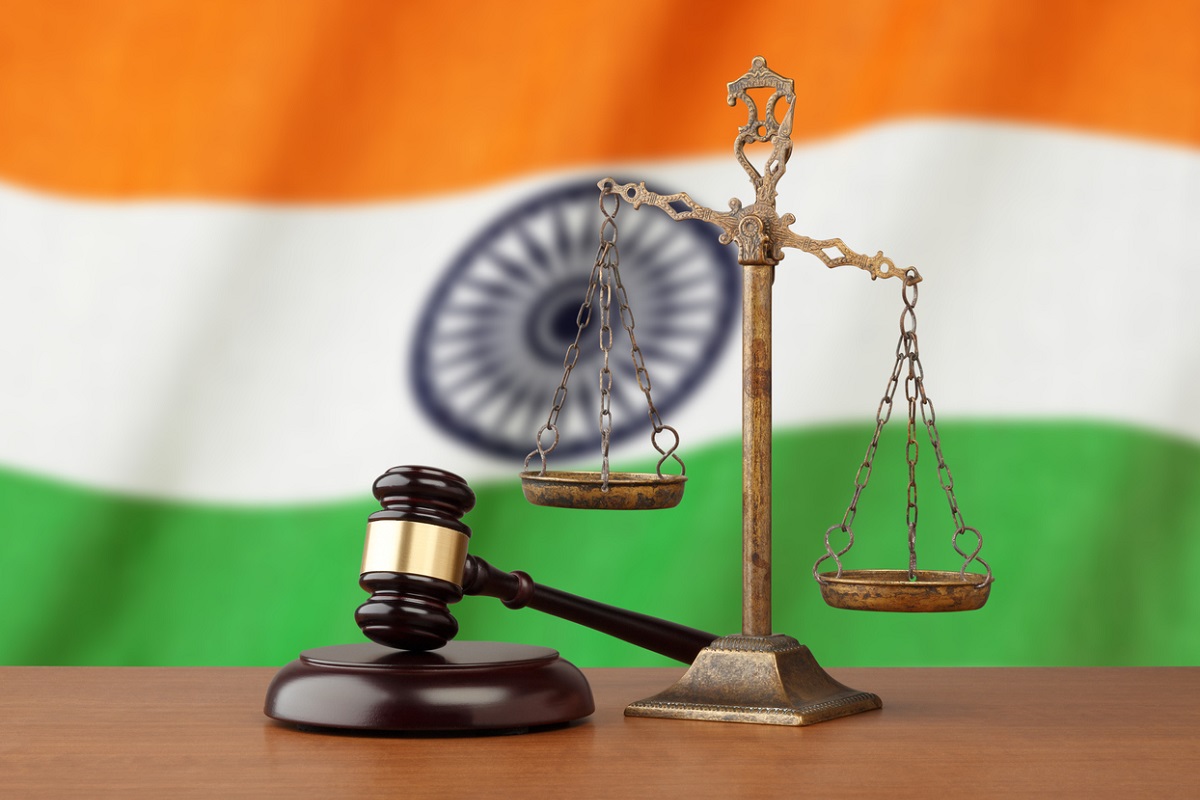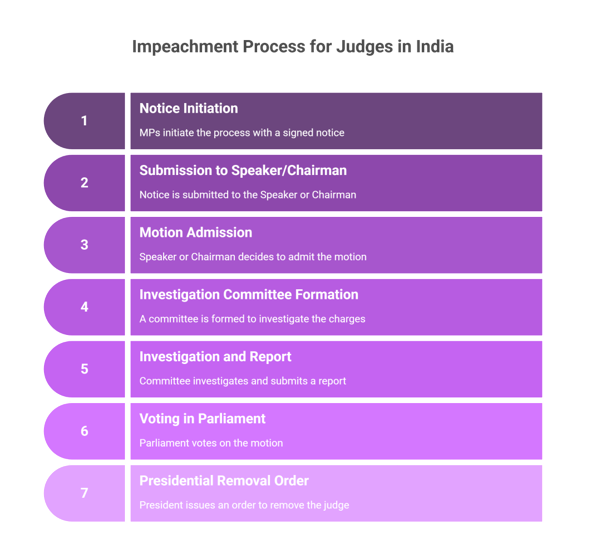- Courses
- GS Full Course 1 Year
- GS Full Course 2 Year
- GS Full Course 3 Year
- GS Full Course Till Selection
- Online Program
- GS Recorded Course
- NCERT (Recorded 500+ Hours)
- Polity Recorded Course
- Geography Recorded Course
- Economy Recorded Course
- AMAC Recorded Course
- Modern India, Post Independence & World History
- Environment Recoded Course
- Governance Recoded Course
- Science & Tech. Recoded Course
- International Relations and Internal Security Recorded Course
- Disaster Management Module Course
- Ethics Recoded Course
- Essay Recoded Course
- Current Affairs Recoded Course
- CSAT
- 5 LAYERED ARJUNA Mentorship
- Public Administration Optional
- ABOUT US
- OUR TOPPERS
- TEST SERIES
- FREE STUDY MATERIAL
- VIDEOS
- CONTACT US
Judges & Justice: Balancing Power and Accountability
Judges & Justice: Balancing Power and Accountability
24-05-2025

What Happened?
- Recently, a large amount of unaccounted cash was found at the home of Justice Yashwant Varma who was a Delhi High Court judge at that time.
- The Supreme Court (SC) formed an internal panel of judges to look into the matter. This panel found him guilty of misconduct.
- Vice President Jagdeep Dhankhar said that this internal inquiry had no legal value and demanded that a criminal case (FIR) should be filed against the judge.
- He also questioned an old Supreme Court decision called the K. Veeraswami vs Union of India and Others, 1991 judgment, which is very important in deciding whether criminal cases can be filed against sitting judges.
Why are Judges Given Special Protection?
- Judges are expected to make fair decisions without being scared of anyone.
- If criminal cases could easily be filed against them, anyone unhappy with their judgment like politicians, powerful people, or even common citizens could misuse the law to threaten or harass them.
- So, the Constitution of India provides judges with special protection.
- The only official way to remove a judge is through a process called impeachment.
- Impeachment needs the approval of Parliament. No judge has ever been successfully impeached in the last 75 years.
What is an In-House Inquiry?
- Since impeachment is so rare, the Supreme Court created an informal method called the in-house inquiry.
- It is not based on any law or constitutional provision.
- In this system, senior judges examine whether there is a valid complaint against a judge.
- If they find the complaint to be serious, they report their findings to the President and Prime Minister.
- However, this process does not lead to criminal punishment. It can only lead to actions like transferring the judge or taking away their judicial work.
What is K. Veeraswami vs Union of India and Others, 1991 Case?
- Justice K Veeraswami was the Chief Justice of the Madras High Court in the 1970s.
- He was accused of corruption, and the CBI filed a case against him.
- Justice Veeraswami challenged the FIR in court.
- In 1991, the Supreme Court ruled that judges are public servants and can be investigated under anti-corruption laws.
- However, the court added a very important condition that an FIR cannot be filed against a sitting judge unless the Chief Justice of India (CJI) approves it.
Why is CJI's Permission Needed?
- The Supreme Court said this rule is necessary to protect judges from interference by the executive (the government).
- The Chief Justice is considered the best person to decide if a case against a judge is serious and not politically motivated.
- This rule makes it hard to misuse the legal system against judges but also makes it harder to punish those who may actually be guilty.
How Frequently has This Rule been Used?
- This rule has been used very rarely.
- In 2019, for the first time, the then Chief Justice of India allowed the CBI to register a case against Justice S N Shukla of the Allahabad High Court.
- The allegation was that he helped a private medical college in exchange for favors.
What Happened in Justice Varma’s Case?
- Although the in-house inquiry found him guilty.
- The Chief Justice of India has not given permission to file an FIR. Because of this, the Supreme Court recently refused a petition seeking a criminal investigation.
- The Vice President believes this system makes judges untouchable, even in cases where there is strong evidence.
What are the Challenges?
- Lack of Legal Backing for In-House Inquiries: The in-house inquiry system is not mentioned in the Constitution or in any law. It is an informal process created by the Supreme Court and has no legal power to punish. This makes the findings of such inquiries legally weak and sometimes questioned by other authorities.
- Need for CJI’s Permission Delays Justice: As per the K Veeraswami judgment, no FIR can be filed against a sitting judge without the approval of the Chief Justice of India (CJI). This can delay or even stop legal action, even when there is strong evidence of wrongdoing.
- Impeachment is a Long and Difficult Process: The only constitutional way to remove a judge is through impeachment by Parliament. This process is very rare, highly political, and has never succeeded in independent India. As a result, judges found guilty of misconduct may continue in service without punishment.
- Possibility of Misuse vs. Lack of Action: The rule requiring CJI's permission helps protect judges from false or politically motivated cases. However, it can also shield guilty judges, making them seem above the law.
- Public Trust and Transparency Issues: When the judiciary handles complaints against itself in a closed manner, people may feel justice is not being done. Lack of transparency in in-house inquiries can reduce public faith in the judicial system.
Way Forward:
- Make the In-House Inquiry Process Stronger: Give the in-house inquiry legal backing through a proper law passed by Parliament. Make the process more transparent so people trust that judges are held accountable fairly.
- Create an Independent Body for Judicial Complaints: Set up a separate authority (like a Judicial Complaints Commission) that includes judges, legal experts, and respected citizens. This body can handle serious complaints against judges in a fair and unbiased way.
- Set Clear Rules for CJI’s Permission: Make clear guidelines for when and how the Chief Justice of India should give permission for an FIR. This can stop delays and ensure that serious cases are not ignored.
- Speed Up the Impeachment Process: Although impeachment is rare, the process should be made quicker and less political when there is strong evidence of wrongdoing. Parliament should act firmly but fairly in such cases.
- Balance Between Protection and Accountability: Judges must be protected from false cases so they can do their job without fear. But at the same time, there should be no safe space for corrupt or dishonest judges.
- Increase Transparency and Public Confidence: The public should be informed about the outcome of inquiries and actions taken. This builds trust and shows that no one is above the law, not even a judge.

|
How Can a Judge be Removed in India?
What is Impeachment?
Who Can Remove a Judge?
What Law Explains the Procedure?
Step-by-Step Process of Removing a Judge:
Key Points to Remember
|
|
Also Read |
|
| Public Administration Optional | |
| UPSC Monthly Magazine | Question Answer Practice For UPSC |




